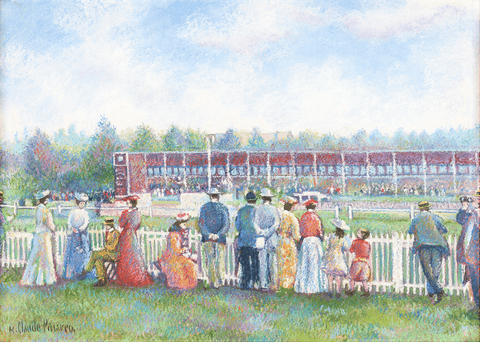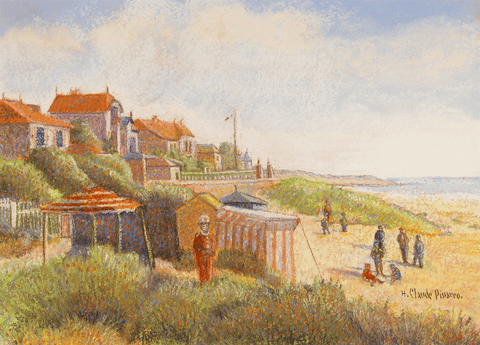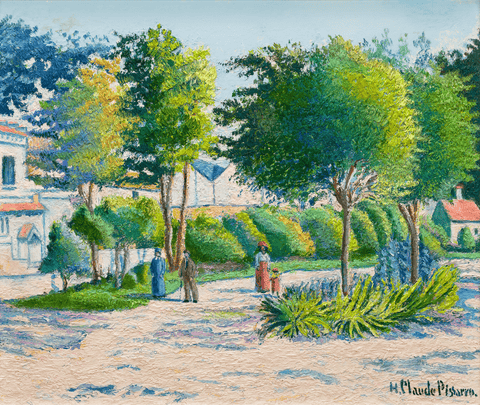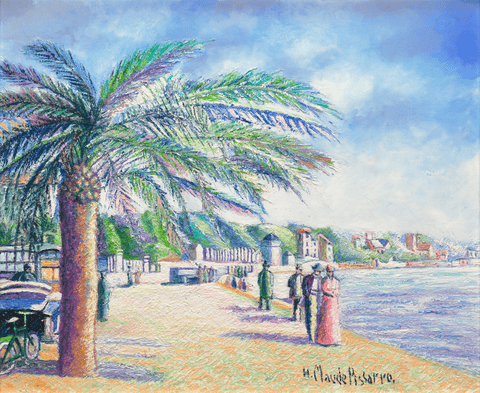Artists & Artisans
Pissarro, Hugues Claude
As the grandson of Impressionist painter Camille Pissarro, Hugues Claude Pisarro carries out his family tradition with the utmost beauty and detail. With vibrant hues and textured brushstrokes, Hugues Claude Pissarro, also known professionally as H. Claude Pissarro, Hugues Claude Pissarro dit Pomié or Isaac Pomie, has produced an incredible body of work in his lifetime. Pissarro utilizes a profusion of color and painterly pastel strokes to create visually intoxicating work that typifies nature in its truest form. Throughout his oeuvre, Pissaro uses beautiful pastels that exemplify the intimate and expressive potential of the medium.

Early Life
Born in 1935 in Neuilly-sur-Seine, H. Claude Pissarro was named after his godfather, Claude Monet. Paulémile Pissarro, H. Claude’s father, was one of five sons to the great Camille Pissarro and was taught by his father in an informal art school within the home. Keeping the family tradition alive, H. Claude was also taught to paint by his father. He exhibited talent at an early age and his predecessors were eager to observe the artwork he produced.

Gourdine, a man luxuriates in the afternoon sun as he sits beside his boat on the banks of the Marne river in this picturesque vista of the French countryside. The French Painter renders his idyllic scene in exquisite detail, utilizing a plethora of painterly brushstrokes to create the windswept tall grasses, verdant trees and reflective blue water.
A Wide Breadth of Styles
Although the Pissarro family legacy mainly consists of Impressionism and Post-Impressionism, of which H. Claude excels in, he painted in a wider breadth of styles including abstract, minimalist, and conceptual work. In fact, at the age of 24, he was commissioned by the White House to paint a portrait of 34th U.S. President, Dwight D. Eisenhower. Due to his early and collaborative exposure to the art world, H. Claude’s work evolved throughout his career as he touched on these differing styles.

Later Career and Legacy
After experimenting with many different styles and mediums, H. Claude always returns to his signature Post-Impressionistic style. However, the artist’s work continues to reflect his passion for producing both his classic Post-Impressionistic pieces along with different styles.

Artists & Artisans
Pissarro, Hugues Claude
As the grandson of Impressionist painter Camille Pissarro, Hugues Claude Pisarro carries out his family tradition with the utmost beauty and detail. With vibrant hues and textured brushstrokes, Hugues Claude Pissarro, also known professionally as H. Claude Pissarro, Hugues Claude Pissarro dit Pomié or Isaac Pomie, has produced an incredible body of work in his lifetime. Pissarro utilizes a profusion of color and painterly pastel strokes to create visually intoxicating work that typifies nature in its truest form. Throughout his oeuvre, Pissaro uses beautiful pastels that exemplify the intimate and expressive potential of the medium.

Early Life
Born in 1935 in Neuilly-sur-Seine, H. Claude Pissarro was named after his godfather, Claude Monet. Paulémile Pissarro, H. Claude’s father, was one of five sons to the great Camille Pissarro and was taught by his father in an informal art school within the home. Keeping the family tradition alive, H. Claude was also taught to paint by his father. He exhibited talent at an early age and his predecessors were eager to observe the artwork he produced.

Gourdine, a man luxuriates in the afternoon sun as he sits beside his boat on the banks of the Marne river in this picturesque vista of the French countryside. The French Painter renders his idyllic scene in exquisite detail, utilizing a plethora of painterly brushstrokes to create the windswept tall grasses, verdant trees and reflective blue water.
A Wide Breadth of Styles
Although the Pissarro family legacy mainly consists of Impressionism and Post-Impressionism, of which H. Claude excels in, he painted in a wider breadth of styles including abstract, minimalist, and conceptual work. In fact, at the age of 24, he was commissioned by the White House to paint a portrait of 34th U.S. President, Dwight D. Eisenhower. Due to his early and collaborative exposure to the art world, H. Claude’s work evolved throughout his career as he touched on these differing styles.

Later Career and Legacy
After experimenting with many different styles and mediums, H. Claude always returns to his signature Post-Impressionistic style. However, the artist’s work continues to reflect his passion for producing both his classic Post-Impressionistic pieces along with different styles.








